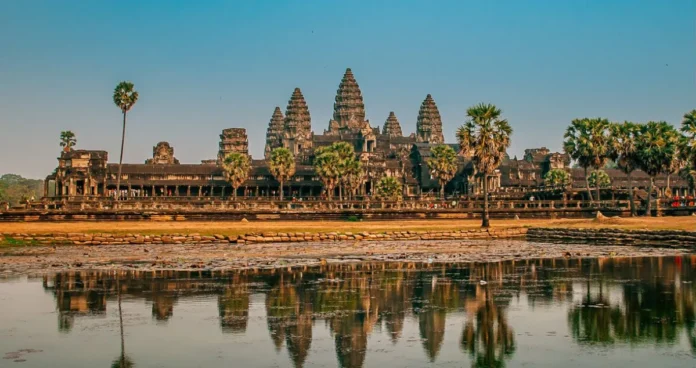Angkor Wat, Cambodia, is one of the best old temples. The temple was constructed in the 12th century as a Hindu temple but later changed to a Buddhist Site. The temple has amazing architecture, featuring detailed carvings and huge structures. It is undoubtedly in the center of a large moat and surrounded by beautiful gardens. The rich history of Cambodia, represented through Angkor Wat, magnetizes the world and attracts people to come and admire its beauty and learn about the place’s past.
Let’s Dive Into the Background and Prestige of Angkor Wat
1. What makes Angkor Wat historically important?
Angkor Wat is historically important for several reasons. It was originally a Hindu temple dedicated to the god Vishnu. It was built in the 12th century and converted into a Buddhist site. Angkor Wat in Cambodia is another huge, brilliantly carved, and architecturally unique structure depicting the advanced skills of ancient builders. It was considered to symbolize Cambodia’s rich cultural heritage. It is one of the best-preserved examples of classical Khmer architecture.
Angkor Wat’s historical value is even more highlighted by its role in demonstrating the grandness and artistic capacity of the Khmer Empire. Constructed during the reign of King Suryavarman II, it served as a state temple and a mausoleum dedicated to him. It is like presenting a miniature model of the universe in stone, with the earthly model for the cosmic world presenting a symbolic representation of it at the temple.
The site reflects the Khmer Empire’s turn from Hinduism toward Buddhism. Withstanding all kinds of wars, invasions, and natural disasters, Angkor Wat has retained its significance as a cultural identity and a reflection of Cambodian resilience.
Relevant Search: Devprayag Sangam, Road Conditions and Travel Tips
2. Where is Angkor Wat located?

Angkor Wat is located in the northwestern part of Cambodia, near the city of Siem Reap. Its rich history and beautiful landscapes characterize the area. This complex is located in Angkor Wat, Cambodia, within a large complex of temples at the center of the Khmer Empire. This temple sits in the middle of a large moat, surrounded by gardens, making it one of the places most visited by people who want to see the ancient past of the country.
3. How to reach Angkor Wat from major cities of Cambodia?
You can explore the wonders of Angkor Wat right here in Cambodia, with the best ways to get to this iconic temple from various major cities across the country.
From Phnom Penh
How to reach by bus?
You can take the bus from Phnom Penh to Siem Reap. It will be quite long, about 6-7 hours. Many bus companies offer comfortable and affordable trips along this route. Upon reaching Siem Reap, get off and travel by tuk-tuk or taxi to conveniently visit Angkor Wat.
How to get there by plane?
The fastest route from Phnom Penh to Angkor Wat is a direct flight to Siem Reap, the closest city, which takes around 45 minutes. You will need to hire a taxi or tuk-tuk from the Siem Reap airport; this trip to Angkor Wat will take you about 20 minutes.
How to get there by car?
The drive from Phnom Penh to Siem Reap takes about 5-6 hours, depending on traffic. The road is pretty good, and you’ll drive through some very beautiful countryside.
From Sihanoukville
How to reach by bus?
You can take a bus from Sihanoukville to Siem Reap, but it will be quite a long journey, like 10-12 hours. This option will be good if you want to save your money and don’t mind a longer journey. Once you arrive in Siem Reap, it’s easy to get to Angkor Wat.
How to get there by plane?
You can take a direct flight from Sihanoukville to Siem Reap. This will take you about 1 hour. At Siem Reap, you can reach Angkor Wat by taxi or tuk-tuk.
From Battambang
How to reach by bus?
This journey takes approximately 3-4 hours by bus, which several companies operate daily. Starting from Siem Reap, take a tuk-tuk or taxi and drive to the nearby Angkor Wat.
How to get there by boat?
You can take a boat from Battambang to Siem Reap. The boat ride along Tonle Sap Lake takes about 6 to 8 hours, depending on the water level. Once you arrive in Siem Reap, you can easily reach Angkor Wat.
From Siem Reap
How to reach by car?
Located in Cambodia, Angkor Wat is but a 20-minute drive from the town center of Siem Reap. You can hire a tuk-tuk or taxi for the day and visit the whole Angkor Archaeological Park that encompasses Angkor Wat.
How to get there by bicycle?
You can rent a bike in Siem Reap and cycle to Angkor Wat. The roads are generally quite flat, and the ride takes 30 to 40 minutes.
From Kampong Thom
How to get there by car?
Driving from Kampong Thom to Siem Reap takes about 3 hours. The road is in good shape and offers a nice view. Once you get to Siem Reap, it’s only a 20-minute drive to Angkor Wat.
How to reach by bus?
Kampong Thom is roughly midway between Phnom Penh and Siem Reap. Traveling by bus from Kampong Thom to Siem Reap takes about 3 to 4 hours. Once in Siem Reap, you can take a tuk-tuk or taxi for the short drive to Angkor Wat.
From Kampot
How to reach by bus?
From Kampot, you can also take a bus to Siem Reap. Although it takes about 12-14 hours, which isn’t that attractive to many of us, it’s a great option if you are on a tight budget. Once you have reached Siem Reap, getting to Angkor Wat by tuk-tuk or taxi is very easy.
How to get there by plane?
You can take a bus or car from Kampot to Phnom Penh; this trip will take you around 3 to 4 hours. Fly to Siem Reap from Phnom Penh. This will cut a long journey to a short one.
4. Best Places to See in Angkor Wat, Cambodia
Here is the list of famous tourist spots in or near Angkor Wat, Cambodia.
| Spot | Distance from Phnom Penh (capital city) | Rating 1-5 |
| The Central Temple | 315 km | 5 |
| The Outer Gallery | 315 km | 5 |
| The Reflecting Ponds | 315 km | 4.5 |
| The Terrace of the Elephants | 316 km | 4.5 |
| The Angkor Thom | 316 km | 5 |
| Ta Prohm Temple | 318 km | 5 |
| Banteay Srei Temple | 340 km | 4.5 |
| Preah Khan Temple | 317 km | 4.5 |
| Angkor National Museum | 317 km | 4 |
| Phnom Bakheng Temple | 320 km | 4.5 |
| Neak Pean Temple | 325 km | 4 |
5. When to Visit Angkor Wat
The best time to be in Angkor Wat, Cambodia, is from November to March, as this period is considerably less hot and dry, which easily opens the possibility of visiting these temples. April to June is even hotter with increased humidity. The rainy season runs from July to October, accompanied by frequent showers and excessive humidity. Visiting between November and March gives you the best weather and fewer crowds.
Matching your interest: How to Reach Gangotri, the Holy Dham A Step-by-Step Guide
6. Where to Stay in Angkor Wat
For a comfortable stay near Angkor Wat, Cambodia, consider the luxurious Sofitel Angkor Phokeethra, which offers elegant rooms and beautiful gardens. Park Hyatt Siem Reap offers tasteful, lavish living combined with first-rate service located near the temples. If your pocket’s a little thin, then Lotus Blanc Resort is modern living at a good price. Banteay Srei Hotel is another budget option, and access to Angkor Wat in Cambodia is quite easy. To stay in something more unique, the Golden Temple Villa gives you charming stays that are emulative of the traditional Khmer style.
Recommended Hotels in Angkor Wat
| Hotel | Facilities | Starting Price | Rating |
| Sofitel Angkor Phokeethra | Luxury rooms, garden, pool, golf course | $150/night | 4.8 |
| Park Hyatt Siem Reap | Stylish rooms, spa, pool, dining options | $200/night | 4.7 |
| Lotus Blanc Resort | Modern amenities, pool, restaurant | $80/night | 4.5 |
| Banteay Srei Hotel | Comfortable rooms, restaurant, free Wi-Fi | $50/night | 4.3 |
| Golden Temple Villa | Traditional Khmer style, pool, free breakfast | $40/night | 4.4 |
| The Privilege Floor | Luxury suites, private butler service, pool | $250/night | 4.9 |
| Belmond La Résidence d’Angkor | Elegant rooms, spa, pool, fine dining | $300/night | 4.8 |
| Tara Angkor Hotel | Modern rooms, pool, restaurant, free shuttle | $70/night | 4.4 |
| Angkor Village Resort | Traditional design, spa, pool, restaurant | $90/night | 4.5 |
| La Palmeraie Boutique Hotel | Cozy rooms, garden, pool, restaurant | $60/night | 4.3 |
| Lotus Villa Boutique Hotel | Elegant rooms, pool, spa, free breakfast | $55/night | 4.2 |
| Khmer Mansion Residence | Traditional Khmer decor, pool, free Wi-Fi | $65/night | 4.4 |
7. Key Considerations for Booking Accommodations
Before booking your stay in Angkor Wat, there are a few things to note down.
- Check up on the reviews your fellow travelers are giving; these can provide you with useful details about how good—or enjoyable—each place to stay actually is.
- The cheapest deal can be found by comparing prices on websites and travel agencies.
- Things to Consider Consideration is given to the factors of where it is, what it offers, and how much it costs to reach a decision.
- Early Booking A hotel should be booked in advance, especially during the peak periods.
8. Religious Spots of Angkor Wat
The Central Temple
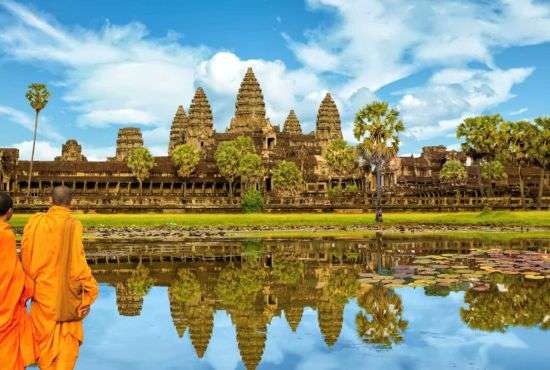
The main temple of Angkor Wat in Cambodia was first built as a Hindu temple for Vishnu. Its detailed carvings and impressive design show its religious importance.
The Outer Gallery
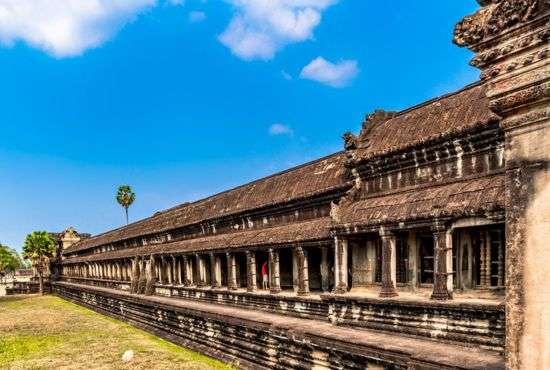
This area has detailed carvings showing stories from Hindu mythology, such as the famous “Churning of the Ocean of Milk,” which reveals the religious importance of the whole temple.
The Bayon Temple
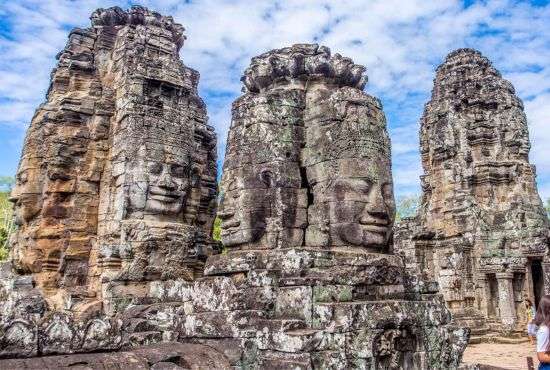
The Bayon Temple is in Angkor Thom, just north of Angkor Wat in Cambodia. It is famous for its huge stone faces, which are believed to represent the Buddhist figure of Avalokiteshvara. Therefore, it reflects its importance in Buddhism.
Ta Prohm Temple
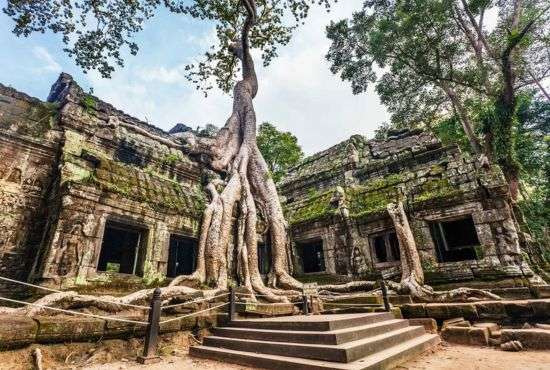
Ta Prohm is famous for its big trees growing over its ruins. In the past, it was originally a Buddhist monastery, and some special, magic feeling showing its spiritual history comes with it.
Banteay Srei Temple
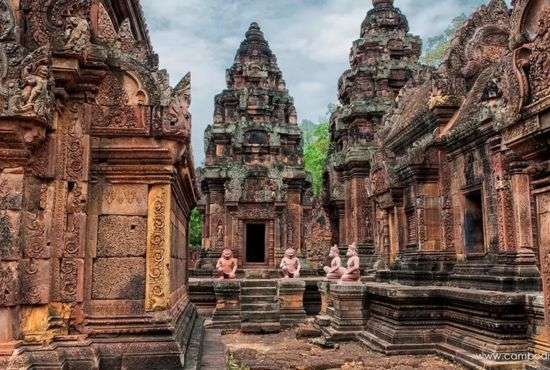
Located farther away from Angkor Wat, Cambodia, Banteay Srei is a temple dedicated to the Hindu god Shiva. It is famous for its delicate carvings on pink sandstone.
Preah Khan Temple
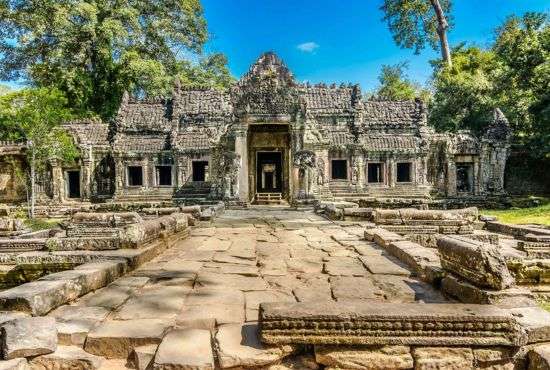
Preah Khan itself was another important Buddhist temple that had served as both a school and royal home, a testament to its importance for religion and culture alike.
Banteay Kdei Temple
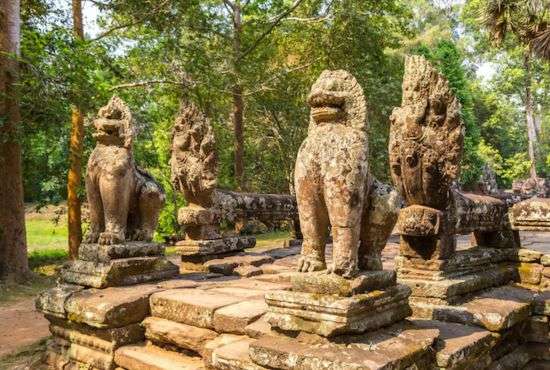
This large Buddhist temple, constructed during the late 12th century, lies near Ta Prohm. It has big galleries and is characterized as a quiet and silent place.
9. Things to Do in Angkor Wat, Cambodia
Hot Air Balloon Ride
Take a hot-air balloon ride over the Angkor Temples for a unique view of the temples and the beautiful countryside surrounding them. This provides an excellent panoramic view and a memorable experience.
Traditional Khmer Meal
Taste some of the authentic Cambodian cuisine in various Siem Reap local restaurants. These include the coconut curry, popularly called Amok, and Khmer BBQ.
Cycle Around the Temples
Rent a bicycle and self-drive around the Angkor Archaeological Park. With this, you will be in a position to view the Temples and the green landscape without finding yourself amidst the crowds.
Cultural Show
Attend the traditional Apsara dance performance or other Khmer cultural performances in Siem Reap. These reveal age-old traditions in dance and music.
Explore the Angkor Silk Farm
Visit the Angkor Silk Farm to see how silk is produced, from the silkworms to the finished fabric. You can also buy some high-quality silk products.
10. Tourist Spots other than Temples
Siem Reap

This city is the entrance to Angkor Wat, with so much more local charm to offer in terms of colorful markets, live nightlife, and diverse dining. Explore the Old Market for local crafts and souvenirs, or enjoy a cultural performance at the Apsara Theatre during your evenings. There are also many boutique shops and cafes that offer a taste of local culture in Siem Reap.
Cambodia Landmine Museum

It is located approximately 20 km from Angkor Wat and offers crucial insight into the impact of landmines in Cambodia. Exhibits inform about the history, impacts on local communities, and efforts of landmine clearance.
Angkor National Museum

This museum, located in Siem Reap, provides a glimpse into the Khmer history and culture. It contains artifacts from the Angkor period that help contextualize the temples and their significance.
Artisans Angkor
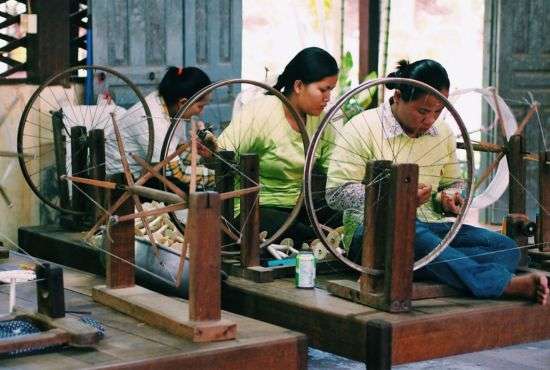
This cultural center, based in Siem Reap, supports traditional Cambodian craftsmanship from artisans who produce fine silk, wood carvings, and other beautiful handmade goods. It’s a great place to understand and buy real Cambodian art.
Tonle Sap Lake
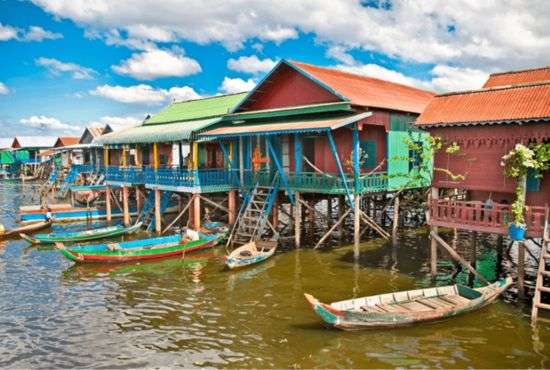
Only a short drive from Siem Reap, Tonle Sap is Southeast Asia’s largest freshwater lake. It is famous for its floating villages, where boat tours allow visitors to explore how local communities live and work on water.
Cambodia War Museum
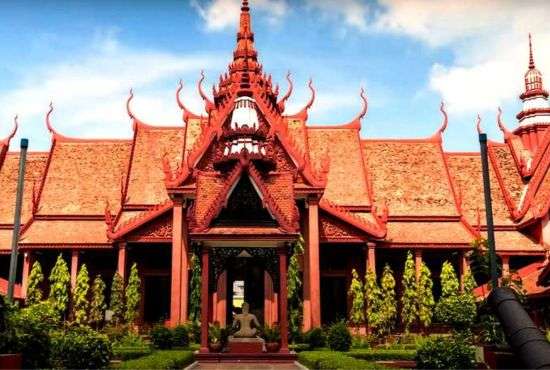
This museum, located just outside Siem Reap, offers exhibits on Cambodia’s recent history. It focuses on the Khmer Rouge period and continuing war efforts. Its collection includes military artifacts and personal stories.
Phnom Kulen National Park

This national park, located approximately 50 km from Angkor Wat, is an array of natural beauty. It offers waterfalls, lush landscapes, and the sacred riverbed carvings of the “River of a Thousand Lingas.” It is also popular for hiking and picnicking.
Siem Reap Art Center Market

This Siem Reap market is a local arts and crafts center where lots of souvenirs are sold, from traditional Khmer art down to hand-tailored jewelry and textiles, making it an excellent spot for getting a taste of the culture and some unique gifts.
People may ask
1. Where is Angkor Wat located?
Angkor Wat is in the northwestern part of Cambodia, not far from Siem Reap. It is within a large complex of temples at the very heart of the ancient Khmer Empire.
2. When is the best time to visit Angkor Wat?
Best to visit from November to March for cooler and dry weather. April to June is hot, and July to October is rainier and has high humidity.
3. What is recommended for visiting Angkor Wat?
Other attractions include the city of Siem Reap, the Cambodia Landmine Museum, the Angkor National Museum, Artisans Angkor, Tonle Sap Lake, the Cambodia War Museum, Phnom Kulen National Park, and the Siem Reap Art Center Market.
4. What are some of the activities open for visitors to do in Angkor Wat?
Activities include rides on hot air balloons, relishing local Khmer food, riding cycles around the temples, watching cultural performances, and visiting the Angkor Silk Farm.
5. What are some of the major religious places in Angkor Wat?
Some of the notable religious spots include the Central Temple, the Outer Gallery, Bayon Temple, Ta Prohm Temple, Banteay Srei Temple, Preah Khan Temple, and Banteay Kdei Temple.
Bottom lines
Angkor Wat, Cambodia, is a stunning ancient temple known for its impressive architecture and rich history. Built in the 12th century, it was a Hindu temple originally before becoming a Buddhist site. The whole temple complex is surrounded by a huge moat and beautiful gardens, which are of high cultural value and are recognizable skills from Cambodia. It’s just outside of Siem Reap town and not too far from major Cambodian towns, thus easily accessible by various means of transport. Visiting between November and March, when it is cooler, is recommended most. There are various categories of accommodation, from five-star luxury to budget-friendly hotels and numerous attractions within walking distance, creating a well-deserved destination for history and culture lovers.



